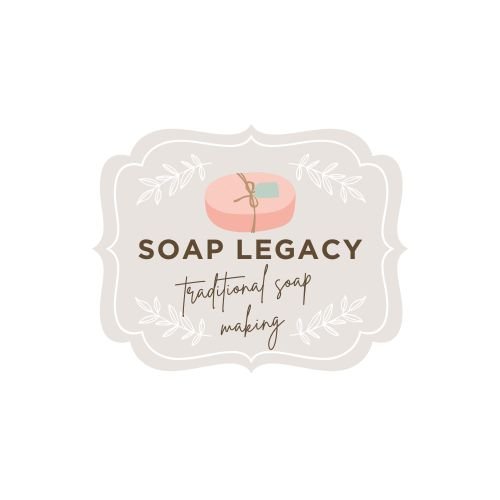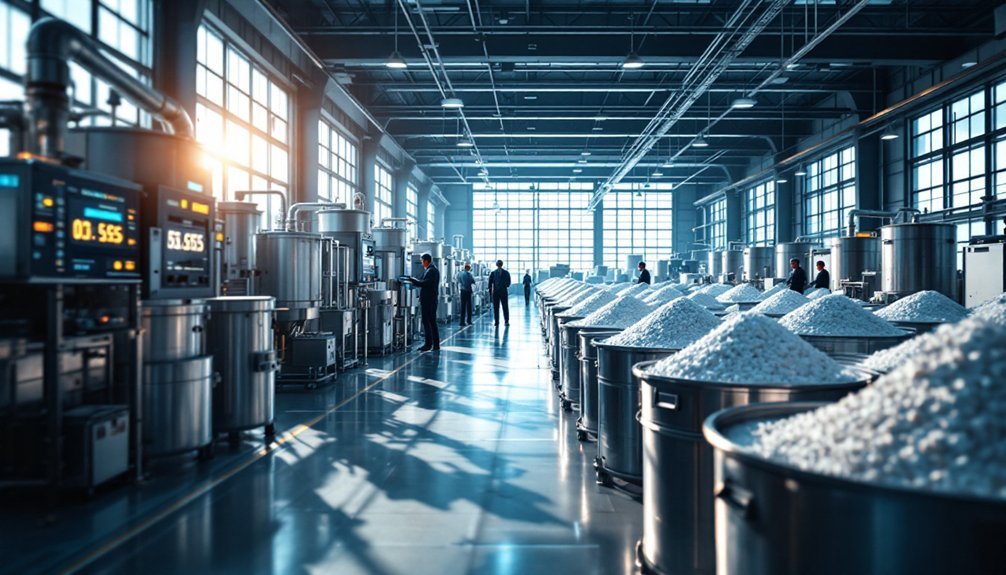Store lye in airtight HDPE #2 plastic containers with secure lids, clearly labeled with the chemical name and hazards. Keep it in a locked cabinet away from children and pets, in a cool, dry area below 85°F. Maintain low humidity and separate lye from acids and combustible materials. Have emergency protocols posted and spill kits ready. Conduct monthly safety inspections of containers and storage areas. These seven rules will help you handle this caustic substance safely.
Choose Proper Containers for Long-Term Lye Storage

When storing lye for extended periods, selecting the right container becomes essential for both safety and preserving the chemical's effectiveness.
Always opt for rigid, airtight containers made from HDPE #2 plastic that prevent moisture absorption, which can quickly degrade lye and create unsafe conditions.
Your storage containers should have tight-fitting lids to minimize accidental spills and keep curious children or pets safe.
Don't forget to clearly label the container with contents and appropriate hazard warnings for quick identification and safe handling.
For enhanced moisture protection and safety precautions, consider placing your lye containers inside a bucket with a gamma lid.
This double-containment strategy provides extra security.
Regularly inspect your stored lye for any signs of deterioration or container damage to maintain safety standards.
Designate a Secure Location Away From Children and Pets

Safety demands storing lye in a dedicated, locked cabinet or high shelf completely inaccessible to children and pets.
This caustic substance requires thoughtful placement in your home to prevent potentially tragic accidents.
Choose a secure storage area that you can lock and maintain exclusive access to. Clearly label this location with hazard warnings so everyone understands the dangerous contents inside.
Your lye containers should be rigid and airtight, with seals checked regularly for integrity.
Remember to inform all household members about where you've stored the lye. This creates awareness and reinforces safety protocols.
Make checking your lye storage part of regular home maintenance – guarantee locks function properly, containers remain undamaged, and the area stays clean and organized.
Maintain Ideal Temperature and Humidity Conditions

You'll need to store your lye solutions at temperatures below 85°F to prevent degradation and maintain stability.
Keep humidity levels low in your storage area since moisture can cause lye to clump or lose effectiveness over time.
Use airtight containers placed in cool, dry locations away from direct sunlight to limit moisture exposure and protect your lye from environmental factors that could compromise its quality.
Control Temperature Fluctuations
Maintaining proper temperature and humidity conditions stands as a critical component of lye storage safety.
You'll need to keep your lye in a cool, dry area below 85°F (29°C) to preserve its effectiveness. Temperature fluctuations pose a significant risk, so store containers away from heat sources like stoves and direct sunlight.
Monitor humidity levels carefully, as high humidity causes lye to absorb moisture from the air, leading to clumping and reduced potency.
Always use moisture-resistant containers with airtight seals to protect against environmental factors that compromise stability.
Make it a habit to regularly check your stored lye for signs of degradation, ensuring storage conditions remain consistent.
Prevent Moisture Exposure
Moisture represents lye's greatest enemy in storage scenarios. To guarantee maximum safety and effectiveness, always store your lye in airtight containers that completely seal out environmental humidity. This simple precaution prevents the chemical from absorbing moisture, which leads to degradation and diminished potency.
Place your storage containers in cool, dry locations away from direct sunlight and heat sources, maintaining ambient temperatures below 85°F (29°C). Regularly inspect your stored lye for clumping or caking—clear indicators of moisture contamination that signal the need for proper disposal.
For added protection, consider placing desiccant packets inside your storage containers to absorb any residual moisture. These preventative measures not only extend your lye's shelf life but also maintain its chemical integrity and guarantee safer handling.
Implement Clear Labeling and Hazard Communication

Always label your lye containers clearly, including the chemical name, concentration, and hazard warnings to prevent accidental mishandling.
Use color-coded labels that distinguish lye from other chemicals and guarantee these labels can withstand moisture without becoming illegible over time.
Post warning signs and safety data sheets near your storage area to provide essential emergency information and maintain regulatory compliance.
Label All Containers
Proper labeling of all lye containers stands as your first line of defense against accidental exposure and misuse. Always mark containers with the chemical name, concentration percentage, and clear hazard warnings that communicate lye's highly corrosive nature.
Include standardized hazard symbols, particularly the corrosive pictogram, to instantly convey danger to anyone who encounters your storage containers. Don't forget to add specific storage instructions and emergency contact information such as your local poison control center.
Maintain consistency in your labeling system across all containers, which builds familiarity among frequent handlers. This predictable format enhances overall safety in your workspace.
Remember to check labels regularly for legibility and promptly replace any that have faded, peeled, or become damaged. Proper labeling isn't just good practice—it's essential protection.
Post Warning Signs
Beyond individual container labels, strategic warning signs throughout your storage area create multiple layers of safety protection. Post prominent signs displaying standardized red hazard symbols that clearly indicate the presence of corrosive materials. Include emergency contact information and basic first aid procedures for lye exposure nearby.
| Warning Sign Type | Purpose | Emotional Impact |
|---|---|---|
| Corrosive Hazard Symbol | Immediate danger recognition | Fear of severe burns |
| "Safety Goggles Required" | Proper handling reminder | Protection confidence |
| Emergency Response Chart | Quick access to poison control | Relief during crisis |
Regularly inspect your signage to maintain it remains visible and legible. You'll need to train everyone who might access the area about these warnings and proper handling procedures. This consistent hazard communication strategy guarantees that even those unfamiliar with your storage setup will immediately recognize the dangers of lye.
Establish Emergency Containment and Spill Response Protocols

Because lye can cause severe chemical burns and damage surfaces instantly, establishing robust emergency protocols is essential for safe handling. Your lye storage area should include designated emergency containment supplies and a detailed response plan.
Don't underestimate the importance of preparation when managing this caustic substance.
- Post your local poison control center number prominently and create step-by-step procedures for handling exposure incidents.
- Maintain a spill response kit containing protective goggles, chemical-resistant gloves, and neutralizing agents like vinegar.
- Train all personnel on proper containment procedures and emergency response techniques.
- Document all incidents in a detailed log to continuously improve your safety measures.
Regular inspection of storage containers will help prevent leaks before they become dangerous emergencies requiring extensive containment efforts.
Separate Lye From Incompatible Chemicals and Materials
Storing lye in close proximity to certain chemicals can trigger dangerous reactions that threaten both safety and property. Always maintain distance between lye and incompatible chemicals, particularly acids, which can cause violent reactions and release harmful gases.
| Incompatible Material | Hazard | Safety Measure |
|---|---|---|
| Acids | Violent reactions | Store in separate cabinets |
| Combustible materials | Fire risk | Keep in different storage areas |
| Food items | Contamination | Use dedicated storage space |
Use corrosion-resistant storage containers specifically for lye and label them clearly to prevent accidental mixing. Since lye is hygroscopic, keep it away from moisture sources to prevent degradation. Dedicated plastic or glass containers with secure lids will help maintain safety and prevent cross-contamination with other household chemicals.
Perform Regular Safety Inspections of Storage Areas
Properly separating and storing lye is only the beginning of safe handling practices.
You'll need to conduct monthly safety inspections of your lye storage areas to maintain a secure environment and prevent accidental exposure.
During your inspections, focus on:
- Container integrity – Check for leaks, wear, or degradation that might compromise safety
- Organization – Keep areas clean and uncluttered to reduce risks and guarantee emergency access
- Safety equipment – Verify eyewash stations and protective gear are accessible and functional
- Documentation – Review and update first aid procedures and safety protocols regularly
These inspections help you identify potential hazards before they cause harm.
Never allow contaminated clothing to remain in the storage area, and always guarantee proper labeling to minimize the risk of accidental exposure.
Frequently Asked Questions
How to Safely Store Lye?
You'll store lye safely by keeping it in airtight HDPE #2 containers, labeled clearly. Don't seal it while hot, check regularly for damage, and lock it away from children and pets. Monitor storage temperatures below 85°F.
What Is the Best Container to Store Lye In?
Store lye in high-density polyethylene (HDPE) plastic containers marked with recycling code #2. You'll want airtight containers, like buckets with gamma lids, that resist corrosion. Don't forget to label them clearly with hazard warnings.
What Not to Do With Lye?
Never mix lye with other chemicals, don't store in metal containers, avoid unlabeled storage, don't keep it accessible to children, and don't use damaged containers. You shouldn't handle lye without proper protective equipment.
Does Lye React With Air?
No, lye doesn't react with air itself, but it's hygroscopic – absorbing moisture from the air. You'll notice it can form clumps and gradually convert to sodium carbonate over time if not stored in airtight containers.
In Summary
Prioritize these seven lye storage rules to protect yourself and your household. You'll prevent dangerous accidents by keeping it in proper containers, in secure locations, with clear labels, and away from incompatible materials. Don't forget to maintain ideal conditions, prepare for spills, and perform regular inspections. When it comes to caustic substances like lye, you're always better safe than sorry.





Leave a Reply